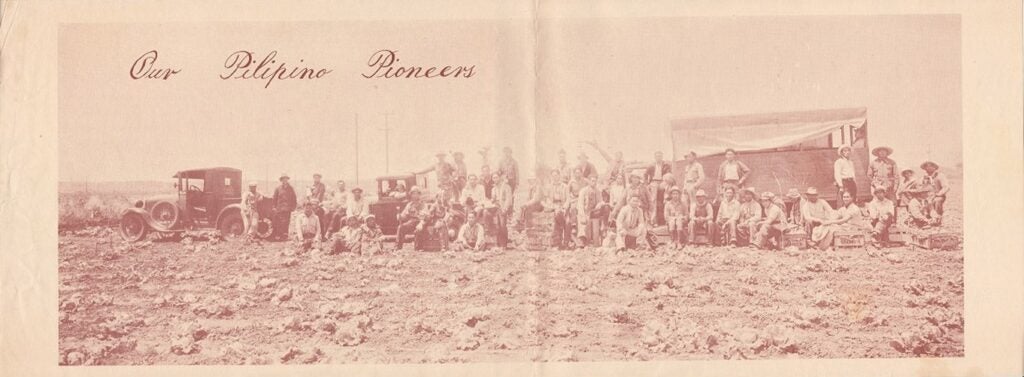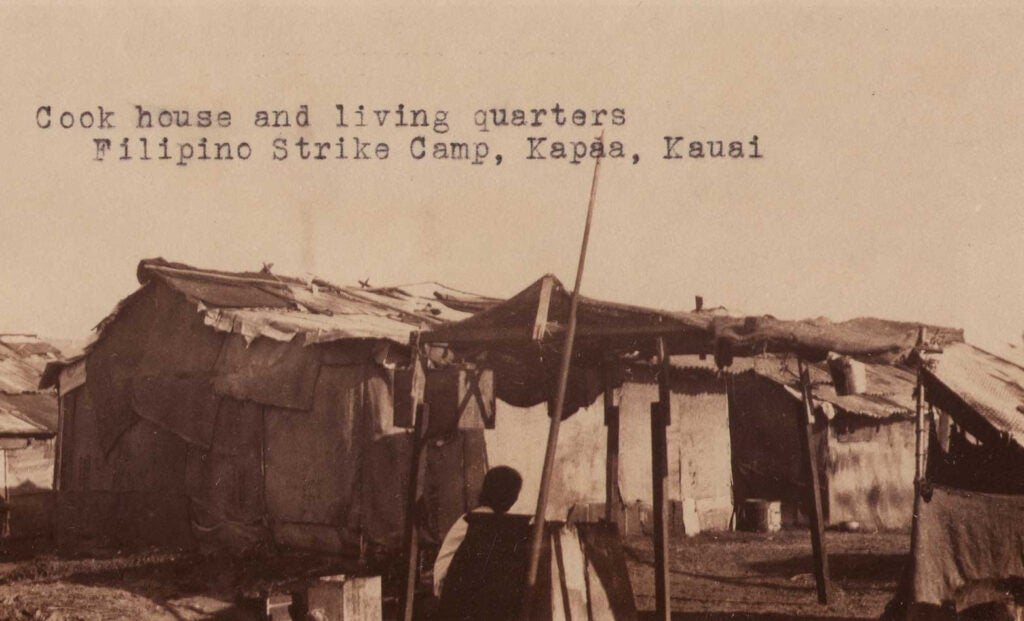Module 1: Overview: Labor & Activism of Filipino Farmworkers
Did Filipino farmworkers achieve justice?
Imagine leaving your home in hopes for a better life and going to a country where you do not know anyone. Imagine being promised an education and life full of prosperity, only to experience discrimination, mistreatment, and exploitation. This was the experience of many immigrants coming to the United States in the early nineteenth century. Imperialism, the Industrial Revolution, and the growth of global capitalism disrupted local economics and politics worldwide. Capitalist countries like the US extracted resources from some countries, including cheap labor. This caused millions of people around the world to emigrate.
The early pioneers who left the Philippine Islands during the early twentieth century were lured by promises of better opportunities. Many were inspired by the pensionados—students who came to the United States from the Philippines on scholarships instituted by the Pensionado Act of 1903—and desired the opportunity to go to school in the US, but had to work as laborers to survive. More than 90 percent of those who left for the continental US and the Territory of Hawaiʻi were male, which meant that there were only a handful of Filipinas who came to the US mainland during the early twentieth century. Filipina/x/o people who arrived in the US from 1906–1934 number about 100,000 and constitute the first major wave of Filipina/x/o immigration to Hawaiʻi and the continental US.

Image 46.01.01 — Filipino farmworkers gather for a group photograph in the cabbage fields of the Salinas River Valley, Salinas, California, circa 1930s.
Courtesy of Welga Digital Archive – Bulosan Center for Filipino Studies. Metadata ↗
In 1898, the Philippines had defeated Spain and won its independence from the Spanish, but the Spanish-American War led to the Philippines becoming a territory of the United States under the Treaty of Paris later that year. This ushered in the Philippine-American War (1899-1902). The end of the war resulted in the Philippines remaining a US territory and the designation of Filipinos as non-citizen “US nationals.” This meant that Filipino immigrants could enter the country without restriction. During the twentieth century, their migration filled a labor vacuum on the West Coast brought about by the 1924 Immigration Act, which prohibited other Asian immigrants from entering the United States.
Most of these Filipina/x/o immigrants were young men under the age of 30. They settled in such West Coast cities as Stockton, San Francisco, Los Angeles, San Diego, Salinas, Watsonville, and Seattle, creating vibrant Little Manilas, Manilatowns, and many Filipino American organizations. They also created highly organized labor unions in the agricultural fields of Stockton and Salinas, and in the Alaskan salmon canneries.
Who are Filipino farmworkers and how were they treated?
How did they respond to the treatment?
What types of justice did they seek?
Farmworkers in Hawaiʻi
Beginning in 1906, the Hawaiian Sugar Planters Association (HSPA) recruited thousands of workers, most of them Ilocanos and Visayans from lower socioeconomic backgrounds. These early migrant workers were recruited to Hawaiʻi as unskilled laborers known as “sakadas.” Between 1909 and 1934, approximately 118,556 sakadas came to work in Hawaiʻi. They eventually outnumbered most ethnic groups on the sugar plantations, including the Japanese. Filipinos, under US colonialism, were considered the ideal labor force because they were deemed to be poor and plentiful, but also cheap and docile.
Assuming Filipinos would be a docile group, the sugar growers of the HSPA initially used them as strikebreakers—workers who keep working or hired after or during a strike to keep the organization running—against the Japanese, Puerto Ricans, and other plantation workers. This strategy, however, proved unsuccessful. The growers did not anticipate the radical labor activism that Filipinos would engage in. Since they were often the lowest paid among the different groups of workers, Filipinos soon joined the fight to secure higher wages and better working and living conditions. In 1919, they formed their own union, the Filipino Labor Union (FLU), led by organizer Pablo Manlapit. Not only was he able to organize Filipinos together, but Manlapit also found common ground with other racial and ethnic groups such as the Japanese, who were the second-largest group of farmworkers.

Image 46.01.02 — A cook house and living quarter at the Filipino Strikers Camp in Kapaa, Kauai, 1925. Camp life was often without running water and electricity. Most of the upkeep of such living spaces were done by the Filipino farmworkers.
Courtesy of Bulosan Center, Hawaii State Archives. Metadata ↗
During the 1920 strike on the island of Oʻahu, the Filipino Labor Union and the Federation of Japanese Labor united to form an interethnic labor strike against the HSPA. Although the strike ended in defeat after six months, the farmworkers did win some concessions, including wage increases, equal pay for equal work, bonuses, and other amenities that improved the working and living conditions for all workers on sugar plantations. Eventually, both unions merged with other ethnic groups to become the Hawaii Laborers’ Association, which later became the United Workers of Hawaii.
Growers saw the organizing tactics and success of labor leaders like Pablo Manlapit as a threat to their plantation systems. Since Hawaiʻi was not yet a state, the territorial government of Hawaiʻi deported him and other “labor agitators” to the continental United States.
From Hawaiʻi to California
Between 1920 and 1929, 56 percent of Filipinos who migrated to the continental US arrived from Hawaiʻi, either through deportation or on their own accord. The second-largest number of immigrants came directly from the Philippines. By 1930, there were 108,260 Filipinos living in the continental US; California, which provided the most opportunities for Filipinos, was home to 31,029.
Thousands of Filipinos migrated to the Pacific West Coast, enticed by letters from relatives and friends that described higher wages and better opportunities in the continental US. The majority of Filipinos who came to the continental US from 1920 to 1934—59 percent—were farmworkers. Although agricultural labor was the largest employer of Filipinos in California, they also engaged in other occupations, including cannery work, domestic service, entertainment, and railroad labor.
Filipino farmworkers who resettled in California came to realize that they faced similar issues to what they had experienced in Hawaiʻi: they were subjected to injustice by their employers and endured long hours of intense labor, only to be rewarded with meager wages and poor living and working conditions. They were relegated to long hours doing backbreaking jobs in the sun for little pay and in labor camps with poor, substandard conditions. For example, many camps were overcrowded shacks or tents, with inadequate outdoor facilities and no running water. In addition, Filipinos were once again the lowest paid farmworkers of all the other ethnic groups.

Image 46.01.03 — Filipino farmworkers with their shared vehicle in 1943. Many Filipino farmworkers would take pictures in their best suits near their cars, despite their harsh working and living conditions, to show their families in the Philippines that they were doing well.
Courtesy of Welga Digital Archive – Bulosan Center for Filipino Studies. Metadata ↗
As in Hawaiʻi, Filipinos demonstrated their militancy in the agricultural fields of California and other locales. One labor report noted that the exploitation and racial oppression of Filipinos fueled their organizing into unions and striking. Their strikes disrupted agricultural production and gained them higher wages, demonstrating that they would not let their employers victimize and take advantage of them. If the growers did not negotiate with farmworkers, whole crops could be lost. As a result, many growers conceded to their demands.
Because of racism and capitalism, Filipinos and other immigrants and workers of color in agriculture, canneries, domestic work, and other industries were exploited and degraded. Filipinos—considered a dispensable, cheap labor source—worked the longest hours, paid the lowest wages, and endured the worst working and living conditions. Filipino farmworkers also faced intense racism in the continental United States. Most white workers saw the grueling work of squatting and stooping as beneath their dignity, and referred to such agricultural work as “Filipino work” or “Mexican work.”
Racism and Violence
Through public riots, physical violence, and legislation, xenophobic and racist white workers, labor unions, writers, and politicians worked to restrict and remove Filipino communities in the United States. They called for (1) an end to Filipino migration to the US through the Tydings-McDuffie Act of 1934, which imposed limits on Filipino immigration; (2) the deportation of Filipinos to the Philippines through the Repatriation Act of 1935; and for some, (3) violence to rid their towns of the Filipino population, which consisted primarily of agricultural laborers. This led to anti-Filipino riots in the late 1920s and early 1930s, in which white supremacist vigilante groups such as the Ku Klux Klan, along with law enforcement, conducted these riots along the West Coast.
These mobs wanted to rid their locales of their “Philippine problem” and were fueled by racist beliefs, accusing Filipinos of taking away jobs and white women from white men. Physical violence, shootings, stabbings, and other acts of racial terrorism left scores of Filipino farmworkers injured. In 1930, at least two Filipinos, Fermin Tobera and Aristo Lampky, were killed. Many Filipinos fled as a result of the riots, but others stayed and resisted. Law enforcement supported the vigilante groups and arrested Filipinos, claiming they were responsible for the riots. These intimidation tactics and riots, however, did not dissuade Filipino workers who continued to organize for better treatment in the fields and in public spaces.
More to explore
Activism and Solidarity in the 1920s and 1930s
Even though they were often beaten, arrested, jailed, shot at, dismissed, and ignored, Filipinos persisted in fighting through militant and highly-organized labor unions. They fought for economic justice by demanding fair wages and working conditions through the collective power of their unions.
Filipinos, along with their Mexican counterparts, have been among the most dominant labor force in California agriculture since the early twentieth century. Seeing their common struggle for social and economic justice, they often joined together against their employers. Often, Filipinos initiated these interethnic unions, building on their legacy of organizing across racial and ethnic groups from years of experience with Japanese workers in Hawaiʻi.
Filipino American farmworkers and their Mexican allies ushered in a new era of interethnic labor organizing during the 1920s and 1930s. Note that the American Federation of Labor (AFL) did not extend membership to Filipinos, Mexicans, and other ethnic groups into their largely white unions early on. As a result, Filipino and Mexican farmworkers went on strike together under the Cannery and Agricultural Workers Industrial Union instead, which was affiliated with the Communist Party and was a farm labor organization. The interethnic unions continued to strike throughout the state of California well into the 1930s, with approximately 140 strikes occurring in this period alone. These interethnic unions occurred in locations such as Stockton, San Diego, Vacaville, the Imperial Valley, Salinas, Guadalupe, Lompoc, Alameda, Santa Clara, Sacramento, San Mateo, Solano, Los Angeles, and Hayward, to name a few.
By 1938, various Filipino labor organizations throughout the West Coast merged to become the Filipino Agricultural Laborers Association. After recognizing the importance and value of their alliances, they later changed their name to the Federated Agricultural Laborers Association (FALA), which included Mexicans and other racial and ethnic groups in their ranks. By 1940, FALA’s membership exceeded thirty thousand members, making it the largest interethnic union of its time.
Filipinos continued their labor organizing efforts in these larger interethnic unions until the bombing of Pearl Harbor on December 7, 1941. Once the United States entered World War II, approximately eighty thousand Filipinos in the continental US and Territory of Hawaiʻi enlisted. This left an acute shortage of labor, which the US filled through the Bracero Program, offering employment contracts to nearly five million Mexican workers from 1942 to 1964.
A New Wave of Interethnic Organizing
Filipino militancy in the fields subsided for the most part until the early 1960s, when Filipino farmworkers began another wave of interethnic organizing with Mexicans and other farmworker groups. This began in the vineyards of Delano, California, where wine grape and table grape growers employed many migrant workers.
On September 7, 1965, Filipino American members of the Agricultural Workers Organizing Committee (AWOC) met at the Filipino Community Hall and voted to go on strike. Larry Itliong, a respected organizer and farmworker who had striked since the 1930s, led the meeting and developed a strategy knowing that if they did not reach out to the Delano’s Mexican farmworkers, employers would hire them as strikebreakers against each other. Itliong approached César Chávez and the National Farm Workers Association (NFWA) to join in their struggle. On September 16, Chávez and co-organizer Dolores Huerta, met with NFWA members, and decided to join the grape strike.

Image 46.01.04 — As the United Farm Workers resumed strike activities against Delano’s table grape growers, Filipino American UFW members rejoined their union brothers and sisters on the picket lines. This image shows a select few Filipino American members of the UFW.
Courtesy of Welga Digital Archive – Bulosan Center for Filipino Studies. Metadata ↗
On August 22, 1966, both unions merged to become the United Farm Workers Organizing Committee (UFWOC). Chávez served as director, while Itliong served as assistant director. Others who served in leadership roles included Dolores Huerta, Philip Vera Cruz, Pete Velasco, Andy Imutan, and Gilbert Padilla. The strike ended in 1970 when the UFWOC and the Delano grape growers reached an agreement that led to higher wages and better working conditions for farmworkers. Despite their successes, however, the alliance between the two groups began showing signs of fracturing. Once the unions merged, Filipino members felt marginalized by the larger Mexican membership. Almost all the veteran Filipino organizers involved in the Delano Grape Strike left the union. Owing to a number of other factors, Itliong also left the UFWOC on October 15, 1971, before the union was renamed the United Farm Workers (UFW) in 1972.
Despite the absence of Filipino leadership and decline in their membership in the UFW in the early 1970s, Filipino contributions to the union were not forgotten. To aid in the retirement and comfort of aging among Filipino and Filipina farmworkers, on June 15, 1974, the UFW finished construction of Agbayani Village, named after Filipino farmworker and UFW member Paulo Agbayani. The first occupants of the new retirement village consisted of fifty-seven men and one woman. On February 21, 2011, Agbayani Village was designated as a National Historical Landmark.
At the beginning of this chapter, we asked you to imagine leaving your home in hopes for a better life, going to a country where you did not know anyone, and being met with adversity. As you learned in this module, the Filipino farmworkers who arrived here experienced racism and even violence, but they did not accept this without resistance. Activism and solidarity provided inspiration and strategies for generations to come. How are you inspired by the Filipino farmworkers’ movement for justice?
Glossary terms in this module
activism Where it’s used
The actions and philosophies that people practice to create positive change in their communities.
Agbayani Village Where it’s used
Agbayani Village was a housing facility built in 1974 for the elderly farm workers who could no longer work or wished to retire. Students and activists from across California came to help raise money and build the facility for Filipino and Chicano elders. Agbayani Village is named after Paulo Agbayani, one of the Filipino farm worker elders who participated early in the Delano Grape Strike but died of a heart attack while picketing on the front lines.
discrimination Where it’s used
When a person or group is treated unfairly based on their race, gender, religion, or other characteristics, rather than on their abilities or actions.
exploitation Where it’s used
The dehumanizing treatment and/or unfair compensation of workers.
justice Where it’s used
Justice refers to the ideal of fairness and equity in the treatment of all individuals, as well as holding individuals and institutions accountable for their actions. This includes ensuring that everyone has equal rights, opportunities, and protection under the law, and taking steps to rectify past injustices. Justice is a fundamental concept in democratic societies and is central to the protection of human rights and the functioning of a fair and just society.
labor organizing Where it’s used
When workers join together to fight for better conditions, pay, and benefits at their job, usually by creating a union.
migrant worker Where it’s used
Someone who moves from place to place, often across national borders, to work temporarily or seasonally.
resistance Where it’s used
The actions taken to oppose and challenge oppressive systems and institutions through forms of collective action such as protests, organizing, and activism. It also includes individual acts of rebellion and refusal to comply with discriminatory laws and societal norms. Resistance is a means for marginalized communities to assert their agency and push for equity and justice.
strike Where it’s used
The actions taken to oppose and challenge oppressive systems and institutions through forms of collective action such as protests, organizing, and activism. It also includes individual acts of rebellion and refusal to comply with discriminatory laws and societal norms. Resistance is a means for marginalized communities to assert their agency and push for equity and justice.
unions Where it’s used
An organization formed by workers, typically from the same industry or company, for the purpose of maintaining and improving the conditions of their workplace.








